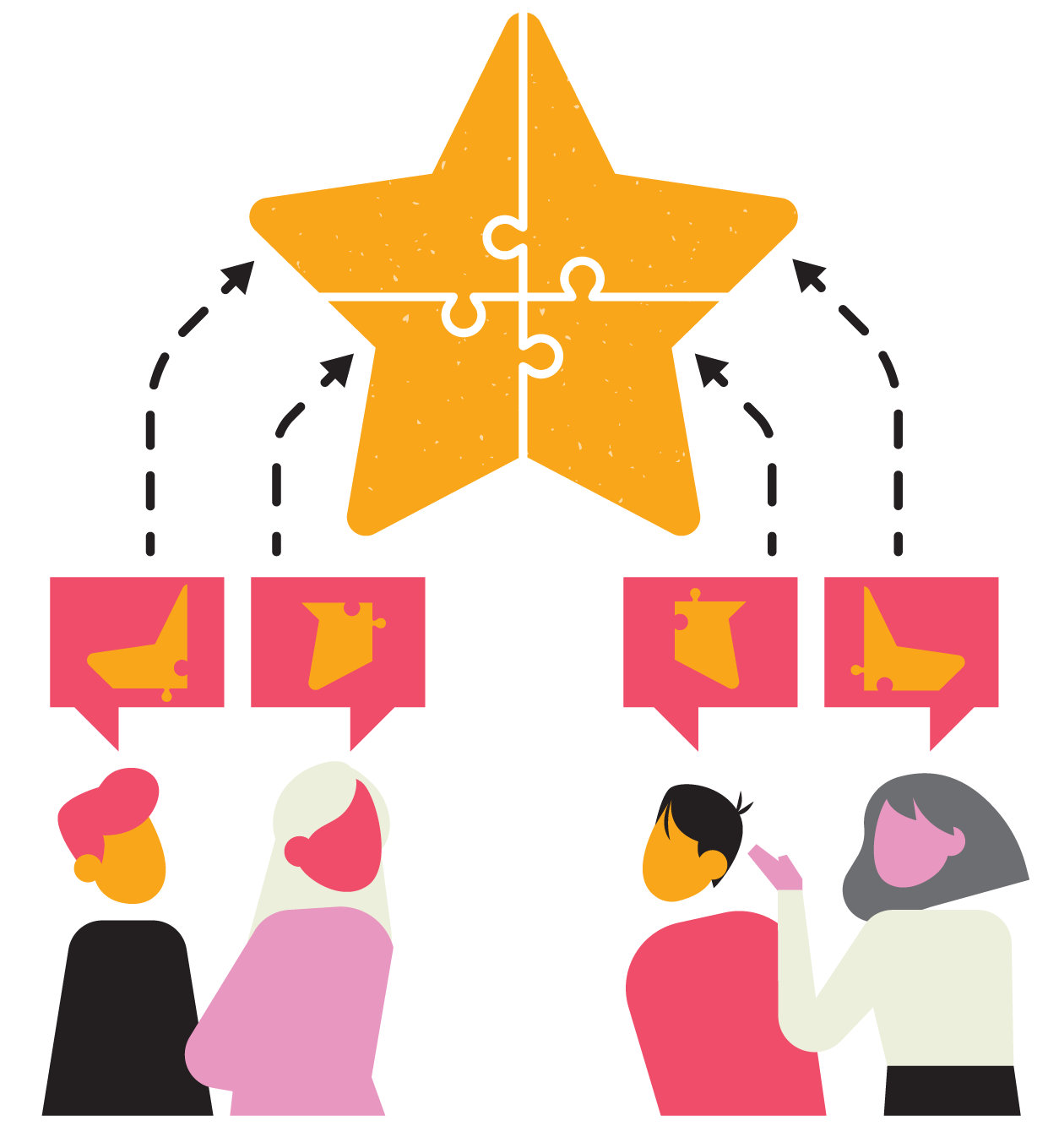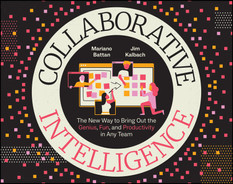
Chapter 2
Relational Intelligence
The Human Aspect of Collaboration
After working for the same entertainment company for 17 years, Fernanda was crying tears of joy for the first time.
The reason she was so happy? A huge in‐person event celebrating a global brand relaunch had been canceled. The 17‐year‐veteran in Brazil had worked hard on the roll‐out with her whole team. The entire global organization the team worked for had as well.
So why did the derailment of this massive effort lead to her feeling like she belonged and was connected to a team more than ever?
In the past, they'd done these types of large‐scale roll‐outs in person. At enormous expense, they'd fly many people in from around the world with the idea that they'd be more productive and connect better when face to face. It seemed like a logical assumption, but it left out a large cohort of people. Those who didn't get flown in still attended, but only over a conference call and from a range of different time zones. Because of the size of the company, privileging in‐person meetings meant excluding some team members.
For over a decade, Fernanda had seen this first‐hand: time differences meant that it was often late at night in Singapore when she and her team joined these calls, and her typically vocal team tended to become mere observers of the “interactions.”
Then the COVID‐19 pandemic changed how teams worked together. Because of travel and gathering restrictions, for the first time, the brand relaunch wasn't held in‐person. Instead it was held completely remotely and asynchronously. Really, the organization felt lucky it was able to put an event together at all during those challenging times.

Something unexpected happened during their collaboration: Participation from locations that had been distant from previous events increased dramatically. A wider variety of people in different types of teams and places felt more connected, both with each other and with the problems they were trying to solve. Even better, the group of people was more diverse in terms of perspective, background, and geographic location. As a result of the increased number of voices included, ideas and concepts were more robust. The content was more globally relevant. And by better connecting teams—even distributed around the world—the speed and quality of their output increased.
Fernanda found that she was able to better leverage her expertise during the event. And as a result, her team became more and more engaged with the global effort and ultimately performed better. The improvement wasn't just due to better videoconferencing technology. The fact that all of the teams were collaborating in the same way—none more distant than others—gave Fernanda, at last, a sense of belonging.
“For the first time in my career, I felt I had a seat at the table,” she said.
This wasn't just luck. The team leads stepped up to design an intentional collaboration experience that created the conditions for Fernanda's voice to be included, regardless of her location. It turns out that there is an upward spiral of positive effects when teams get connected and feel included. Being distributed and connected with digital technology is an incredible opportunity. But it's only a benefit if you take the time to connect in a deliberate way and pay attention to relationships between team members.
Trust Falls Won't Solve Your Problems
You don't hire machines. You hire people. And people are complicated Any attempt at collaboration must explicitly recognize and pay attention to the human aspects of teamwork. Do otherwise—treat people like machines or relegate relationship‐building to a once‐a‐year offsite team‐building exercise—and the inevitable result is disconnected, unproductive, unhappy teams.
We call this focus on connection between people “relational intelligence”. Getting it right makes our teams function better. And smarter.
Relational intelligence involves the ability to be aware of and understand your own and others’ values, needs, styles, and interests. In essence, relational intelligence deals with the interpersonal, human aspects of team collaboration.

Work relationships are social in their own right, and these social aspects matter. They drive effective teamwork, innovation, and the overall mental well‐being of an organization.
Working together on a team isn't easy—especially in today's remote and hybrid world. Despite countless ways to communicate, teams still struggle to collaborate, much less innovate.
Our own research shows that the biggest concern of people working in remote teams is a lack of social connection with colleagues. In the midst of the pandemic in 2020, people indicated in our yearly survey that they missed social interactions with colleagues most.
Other research confirms that social aspects are critical to modern teams. The authors of an article in the MIT Sloan Management Review found that with hybrid workforces now common, deliberate attention must be paid to social connection in remote and hybrid work: “Remote work is now so widespread that organizational leaders must be prepared to manage the negative impact on social climate that can result. This will require conscientious attention to ensuring support from managers and colleagues in both the office and at home.”1
What frustrates you most when collaborating remotely?

Results for Mural's survey on remote collaboration for 2020. 403 total respondents.
In order to solve for disconnection in organizations, human relationships and social aspects of work must be brought into play. Practically speaking, relational intelligence entails getting present to one another, listening, and reflecting. It's also about learning how to share creative ideas and connecting with team members on a meaningful level. And it's not a one‐time thing. You must make it a regular part of how you collaborate.
That starts with deepening your own relational awareness as a collaborator.
The Collaboration Mindset
Simply put, collaboration requires us to work with others. This cannot happen until we recognize our own strengths, weaknesses, and styles of working.
Collaboration starts with the right mindset and extends outward. Three factors most influence our relationships within a group:

Curiosity. Every collaboration is an opportunity to learn. Team members need curiosity—not only about the topic and challenge at hand—but about each other, and they should check egos and biases at the door. The best collaborators are perpetual beginners, always coming to their teams with an open mind, a readiness to accept new ideas and find solutions together.
Respect. Every member of a team must afford the others the emotional and physical space to express their thoughts and ideas, seeking understanding, even when what's shared may seem unusual or even unpopular. The alternative is disastrous, not only because of the negative climate created but the loss of the very ideas and opportunities for creative collisions that power collaboration. Respect is distinct from trust, which implies a sense of earned reliability and truth. While trust is a consistent aspect of high‐performing teams, it's not necessarily a prerequisite for collaboration. Otherwise, we'd never be able to work with individuals we've never met before.
Willingness. True collaboration happens at a deeper level of connection. If team members don't intend to work together, meaningful collaboration won't happen. Sure, a group of people can be brought together to discuss the topics at hand, and they may even cooperate and coordinate with each other. But if there isn't a genuine intent within each team member to work with others, we're really just performing “collaboration theater.”

Intrinsic Motivation
Together, these three factors determine a team member's readiness for collaboration. Patrick Lencioni sums it up well in his book The Five Dysfunctions of a Team (2002): “Great teams ensure that everyone's ideas are genuinely considered, which then creates a willingness to rally around whatever decision is ultimately made by the group.”
These qualities add up to something more than the sum of their parts, too: an intrinsic motivation for collaboration, a passion within you or something you believe in. This differs from extrinsic motivation, which is doing something to win an award or avoid a punishment, or the desire to achieve something based on external pressure. If you consistently cultivate your own curiosity, respect, and willingness for meeting others where they are, being a productive member of a team is its own reward.
Meeting of the Minds
It might be obvious, but from a collaboration standpoint, it's also wonderful: People don't all think alike.
If collaboration is ultimately an alliance of many minds, diversity adds to its effectiveness. In fact, we've noticed a pattern: When teams are “stuck” it's usually due to a lack of diverse perspectives. Bring in an outside opinion or point of view, and things tend to get unstuck. Real innovation happens when a heterogenous alliance of minds forms.
To support—or be part of—teams working together, it's critical to have a basic sense of the ways in which people think can fundamentally differ.
Team Needs
Once you've begun to understand your own thinking styles and the ways others tend to work, it's possible to approach the relationships between team members.
Abraham Maslow's famous hierarchy of needs focuses on the individual in society. But in a culture of collaboration, the unit of analysis is the team itself. So our model of team needs both extends and inverts Maslow's. Team actualization is the ultimate goal, and to get there first requires forming a sense of team safety and team belonging.

Team Safety
Psychological safety describes an overall team climate staked on mutual respect in which people are comfortable speaking their minds, taking risks, and trying out new things without fear of repercussions. High‐performing teams have a great deal of psychological safety built into their standard mode of operation.
Psychological safety isn't just about consensus and harmony within the team. On the contrary, it's psychological safety that enables team members to challenge each other. Teams have to be able to disagree for imagination to flourish. It's possible to be provocative and empathetic at the same time.
The phrase “psychological safety” was popularized by Harvard Business School professor Amy C. Edmondson in her book Teaming (2012). Her definition of psychological safety is straightforward: “A shared belief that the team is safe for interpersonal risk‐taking.” When there is no psychological safety, people check out, and imagination shuts down.
Psychological safety isn't absolute nor is it something leaders can simply “set and forget.” A lack of safety will exist in any team at any time to different degrees because psychological safety is situational, varying from interaction to interaction among team members. Concerns about psychological safety are an ongoing aspect of teams collaborating.
So the real question is how its presence affects contributions from the team. Collaborative intelligence strives to address psychological safety in crafting team experiences and creating an environment that fosters participation, session by session, interaction by interaction.
Generating psychological safety for your teams doesn't have to be a mystery. Alla Weinberg, author of A Culture of Safety (2020), recommends taking some simple steps to get started:

Shift from YOU to I. Demonstrate good collaboration behaviors by avoiding the blame game. Instead, frame your discussion from the “I” perspective. Keep your point of view and language focused on your own experience, and encourage others to do so as well.
Get vulnerable. Don't be afraid to share what's happening for you in the moment and how collaborating together affects you, both practically and emotionally. Show others on your team that it's OK to talk about the experiences together, even if they feel exposed and vulnerable in doing so.
Reflect. Invite others on the team to share what's going on for them in the moment, as well as what past experiences have shaped their behavior and decision‐making. Take time to think about how things are going and what you can do as a group to make it better.
Just consider how teams at Atlassian build trust and psychological safety. For a lot of people, the sudden shift to remote work in early 2020 was a shock to the system. The boundary between work and home was not just blurred, but decimated, and it was harder for team members to feel connected. Eugene Chung, R&D team coach at Atlassian, set about designing a workshop to solve this problem. The result was the Work Life Impact Play, a method you can use to build psychological safety and identify the right support for your team.
Eugene told us that “focusing on skills of true empathy, of being able to understand each other, being able to adapt with each other, and really get you to this point having this deeper sense of trust and connection with your teams, this resilience on teams … [these] are the skills we're trying to build up now.”
One key way to build a sense of belonging is to acknowledge individual contributions. Take time to recognize achievements. The strongest teams we've observed also celebrate wins together. This need not be elaborate award ceremonies with prizes or bonuses. Just a simple “good job” or “thanks for your help” now and then goes a long way toward belonging.
Group Belonging
Sure, skill and talent matter: Each person needs to bring their best self to the table. But talent alone doesn't make a high‐performing team.
In sports, we see time and time again: A roster of top athletes that everyone assumes will dominate the competition ends up losing to teams without superstars who play better together.
A virtuoso musician has to be proficient at their own instrument. But playing in a band requires a different type of facility—listening, adjusting, and reacting in real time—abilities that go beyond individual technical ability.
The “War on Talent” that broke out in the 1990s proved to be counterproductive. Stanford's Jeffrey Pfeffer, for one, has shown in study after study that a fixation on talent only undermines existing teams inside an organization, often leading to a corrosive culture.2
Malcolm Gladwell showed how that kind of competitive dynamic contributed to Enron's downfall.3
Having the right talent is a good thing. But the truth is that talent will be ineffective within dysfunctional teams. Fostering a culture of collaboration requires a sense of belonging: The people on your team need to not just be affiliated with one another, but to also know that they share commonalities. Belonging requires that a bond be somehow made manifest. In collaboration, that often takes the form of alignment.
Alignment is a key factor in creating cohesive teams. Simply agreeing on your purpose isn't enough. In fact, being aligned doesn't always mean being in complete agreement. Teams and companies need to coordinate on how they will act to fulfill their purpose. Not just on a tactical, day‐to‐day level but on a strategic level.
Ryan McKeever, writer and CX leader, puts it like this: “Alignment means everyone can support a decision as if it were their own, even if they might have done something different if they ruled the world....4 Agreement, on the other hand, requires a higher degree of commitment from each person on the team. Agreement means there is unanimity of opinion.”
Group Actualization
Mission statements like “to be the best in our industry” or “to reach half a billion dollars in revenue” are hollow and self‐serving. And they aren't motivating.
Once purpose goes beyond the organization, engagement and motivation increase. That might explain why we're seeing a shift in how organizations approach purpose, expanding the concept beyond just profit and business success. For instance, the concept of “shared value” as developed by Michael E. Porter anchors purpose as a competitive advantage. It's a win‐win approach: You'll not only engage employees and customers in a new way, you'll also outperform your competitors.
In order for work to be meaningful, wrote Malcolm Gladwell,5 it needs to have three characteristics:
- Autonomy. No one wants to be micromanaged—another reason trust is so important in the workplace.

- Complexity. It's hard to stay engaged at work when we're not being challenged. In fact, boredom is the number one reason people consider leaving their jobs, a survey by Korn Ferry suggests.6
- Connection between effort and reward. It's gratifying to see the impact of our work. It's even more satisfying to be rewarded for it. This one's all about extrinsic motivation: getting fairly compensated for the work we do.
Whether at the company or team level, when purpose is meaningful, alignment is easier too. Aligning each team with an overarching purpose and then giving it the autonomy to act gives rise to group actualization, the ultimate state of team fulfillment.
Relationship Goals
Unleashing Your Collective Imagination
There's another way to characterize the ultimate in group actualization: collective imagination. But the kind of imagination we're talking about here isn't about fairy tales and magic dragons; it's about finding ways to solve the world's toughest problems.
Does everyone understand their team's purpose, and their own? Can they see the impact their work is having? If they can—if purposeful alignment is coupled with the kind of psychological safety that encourages risk‐taking—then imagination can flourish in an organization.
But the converse is true, too: regardless of how well the team gets along, and no matter how much they trust each other, it's nearly impossible to activate a collective imagination if your purpose is murky.
Business growth isn't just about number crunching to maximize profit: Increasingly, companies that prosper will distinguish themselves from competitors by first out‐imagining them. Sure, experimentation and delivery are part of the equation, but true differentiation begins with imagination. It's core to innovation. Growth starts with imagination.
Artificial intelligence (AI) and other technologies won't get you there: They might take the “thinking” off your shoulders, but not the ability to imagine a better future. Now more than ever, businesses need to tap into the power of team imagination.
Imagination doesn't only fuel growth, it also drives a team's ability to change themselves. Imagination is key in finding new ways of working together. With imagination, teamwork becomes engaging, productive, and fun.
We believe that innovation and change can happen anywhere, as long as great minds can be connected, collaborating toward a common goal. No longer are only decision‐makers responsible for innovation: Everyone can contribute. It starts with relationships—each other—and leads to imagination, an endless resource that your team can tap into right now.
This is why we implore you to move to make collaboration more deliberate. Because you can do so in a way that harnesses the potential of collective imagination as teams come together to solve problems and innovate. Imagination is one of the incredible functions of the human brain: the ability to see things differently, to conceive of a future that doesn't yet exist. Homo sapiens are the only species able to think counterfactually, and from this perspective, human imagination underlies progress in the world.

Notes
- 1 Caroline Knight, Doina Olaru, Julie Anne Lee, and Sharon K. Parker. “The Loneliness of the Hybrid Worker,” MIT Sloan Management Review (May 2022) https://sloanreview.mit.edu/article/the-loneliness-of-the-hybrid-worker.
- 2 Jeffrey Pfeffer, “Fighting the War for Talent is Hazardous to Your Organization's Health,” Stanford Business working paper (2001).
- 3 Malcolm Gladwell, “The Talent Myth,” New Yorker (2002).
- 4 Ryan McKeever, “How Aligned Is Your Organization?” Huf013 Post (2013).
- 5 Malcolm Gladwell, Outliers (2011).
- 6 Korn Ferry, “Breaking Boredom: Job Seekers Jumping Ship for New Challengers in 2018, According to Korn Ferry Survey,” press release, January 4, 2018, https://www.kornferry.com/about-us/press/breaking-boredom-job-seekers-jumping-ship-for-new-challenges-in-2018-according-to-korn-ferry-survey.
